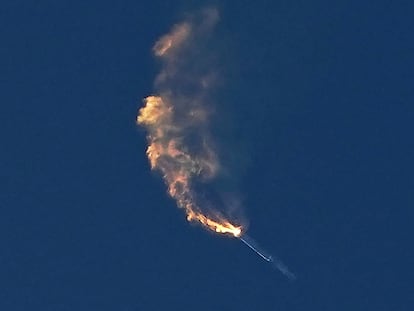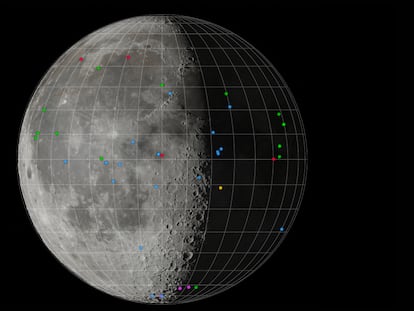Rhiannon Adam, the photographer who will travel to space: ‘I’m taking my trusty Polaroid’
The Irish artist is part of the crew of dearMoon, the first mission that will take artists to the Moon’s orbit

When the Polaroid camera was invented, 70 years ago, it was like sending someone into space. “A kind of magic.” This is how Rhiannon Adam describes the device that revolutionized the way photographers worked. Even her: Adam has used analogue equipment to capture the beauty and nuances of the most remote communities and from different corners of the planet. And now, she will take her trusty Polaroid to a place where very few humans have gone before. The Irish-born, London-based photographer is part of the crew of dearMoon, the first civilian trip that will take her and seven other artists to lunar orbit.
In 2018, Japanese billionaire Yusaku Maezawa bought all the seats on board one of the Starship missions, the largest rocket in history, with which Elon Musk intends to take civilians into space. MZ — as he is known — describes himself as passionate about art and culture, which is why he made a public call in search of a crew of artists and creative people who were willing to accompany him on this space trip to the Moon, which is expected to last approximately one week.
The mission itself is a trailblazer. This will be the first time that artists cross the stratosphere, as well as the first time that analog photography is taken from that height. Depending on the launch date (which has not yet been decided), this fine art photographer could also become the first Irish woman to travel to space, and most likely the first openly LGBTQ+ person to do so. “In many countries around the world, if you are a queer person or a woman, your rights are violated on a daily basis. This is an opportunity to show that people are people, no matter where they come from or their background,” she tells EL PAÍS via video call from a photography festival in France.
Approximately one million people from 129 countries applied to participate in the trip. When Adam heard about the project from a good friend, she thought it was a joke. However, after filling out some forms, undergoing numerous individual and group interviews, and a whole process of medical examinations, as well as a trip to meet the Japanese businessman in Houston, Texas, the fateful call finally came.
“Want to go to space?” MZ himself asked via video call in November 2021.
“Of course,” she replied, enthusiastically.
But she had to keep it a secret. Adam now says, amused, “When you finish a major project, all everyone wants to know is, ‘What are you working on now?’ And you have to say something like, ‘Oh, not much, I’m just going into space, no big deal.’” During that year, she told no one, except her mother. “I expected some of my friends to have a more spectacular reaction, but some of them were like, ‘If someone goes to space, of course it’s going to be you. You’re always doing weird things and going to far-off places.’ I don’t know if I take it as a compliment, or what I can do to surprise them,” she says.
From her personal life to her professional side, the photographer is known for leading an unconventional lifestyle. Her childhood was spent on a boat with her parents: “We didn’t have a house. It wasn’t summer vacation. That’s all we had. This ship was our home, a long-term cruise,” she says about the eight years she traveled around the globe. Those experiences gave her a unique perspective and a set of skills that, she suspects, helped her secure a place on this mission. “I spent a lot of time in tiny metal capsules. I guess there was some kind of synergy,” she jokes.
Although the exact date for the trip has not yet been set, what is certain is that there will have to be three or four successful launches — the first Starship exploded in the air shortly after takeoff — before the crew can begin physical preparations. This will include adopting a new diet, adapting to the attire, and becoming familiar with the surroundings. Among all these preparations, Adam thinks that the biggest challenge has to do with the psychological aspect. “It’s even more relevant than conventional space training, as much of that process has been documented in some way. SpaceX produced a documentary that’s available on Netflix. The training described in it will be quite similar to what we will experience,” she says.
Her main responsibility will be to capture and develop the first analog photograph ever taken from space. And all eyes will be on her technique. As she explains, the worst-case scenario would be returning to Earth to discover that the film is blank. Therefore, it will be crucial to carry out the entire process in the ship. “One of the biggest challenges is to carry out a development process in a non-gravity environment. This will involve designing a system that allows a liquid to be injected under pressure and then suctioned to eliminate it.” She is aware of the technical obstacles, but she remains confident that they are all surmountable. “For the first time in my life I can say that I am surrounded by rocket scientists, specialists in problem-solving. Processing with no gravity will be tricky, as well as drying things. There can be nothing wet, floating or dusty. Even a drop of water could be very destructive. So I can’t do a lot of the things that I normally would, as I could produce particles that would spread everywhere.”
Even seemingly simple actions such as pressing the camera shutter, putting objects in one’s pocket, attaching them to clothing with velcro or clips or preparing materials while everything floats around, take on a new dimension and require a whole new way of moving and working. “It doesn’t always work the same way, depending on what camera you have, because there’s no resistance. Everything was made on Earth to work in the environment in which we are. Floating can affect everything, and a lot of technology needs to be recalibrated.” Still, she notes: “This challenge is a luxury to me.”
Although she does not consider herself a light traveler, she will need to be very austere when deciding what to pack. Of course, always prioritizing her work. “There is a long connection between the Hasselblad [camera] and space, because the original Moon landing photos were taken with one. So I’ll probably take my beloved Hasselblad, which has gone everywhere with me. However, my story actually revolves around the Polaroid,” she says.
One of the most interesting aspects of Polaroid photos is watching how the photographic paper that comes out of the camera begins to take shape and color. You can see how the image gradually materializes, and any action leaves traces on it. “If you hold it too hard, it will leave a mark. If you shake it, it will leave another. If it’s too cold or too dry, it will change the way the Polaroid looks. There’s a kind of beauty in that, because it’s a physical relationship with the space and the time in which the image was taken,” she explains. There is also a historical relationship; Moon landings were paused around the time the Polaroid camera came on the market, and its inventor was also an advisor to the United States space program. “There was always a sort of continuity and fusion between these technologies. I want to be able to capture that, absorb the physical environment and then be able to bring it back,” she explains.
While there are exhibitions with some basic objects, such as the water bottle or the socks of the astronauts, there has never been a display case with elements that were produced inside a rocket. “There has never been an exhibition made from works created in space, because no artists have ever been there before. This is really the first time that there is an opportunity to send artists to interpret it from a different perspective. And to be able to physically bring something back,” she says. In addition, SpaceX will equip the entire rocket with cameras, so that the public can see how the work is done in real time.
The artist is aware of the political and social aspect that this mission implies in both the personal and the collective spheres. “There are certain places in the world that are difficult for me to visit, because if you Google me, it’s very easy to see my face, to identify me and know what my sexual orientation is. Not that I’m hiding it. But unless someone asked me directly, I wouldn’t say anything. However, now I don’t have that option. Things have changed, but I felt like this was something important to do,” she says. “Something important” is, among other things, using her “position of privilege” to generate visibility.
Her goal is, above all, to impact those who create the rules, the laws, as well as those who are outside. “It’s the everyday people who you need to convince. It’s great to be able to represent my community, but the best form of representation is to be visible in the public sphere, not to avoid it, and to prove that there is really nothing threatening in me or mine, regardless of gender or sexuality,” she says. However, that does not mean that her art has to be focused on the LGBTQ+ community. Just being part of it is enough for her. “I don’t need to do a project about queer people for it to be about queer people. I am queer.”
Sign up for our weekly newsletter to get more English-language news coverage from EL PAÍS USA Edition
Tu suscripción se está usando en otro dispositivo
¿Quieres añadir otro usuario a tu suscripción?
Si continúas leyendo en este dispositivo, no se podrá leer en el otro.
FlechaTu suscripción se está usando en otro dispositivo y solo puedes acceder a EL PAÍS desde un dispositivo a la vez.
Si quieres compartir tu cuenta, cambia tu suscripción a la modalidad Premium, así podrás añadir otro usuario. Cada uno accederá con su propia cuenta de email, lo que os permitirá personalizar vuestra experiencia en EL PAÍS.
¿Tienes una suscripción de empresa? Accede aquí para contratar más cuentas.
En el caso de no saber quién está usando tu cuenta, te recomendamos cambiar tu contraseña aquí.
Si decides continuar compartiendo tu cuenta, este mensaje se mostrará en tu dispositivo y en el de la otra persona que está usando tu cuenta de forma indefinida, afectando a tu experiencia de lectura. Puedes consultar aquí los términos y condiciones de la suscripción digital.
More information
Archived In
Últimas noticias
Trump claims peace in Ukraine is near, but Moscow suggests otherwise
A survivor’s account of the Interoceanic Train accident: ‘We were scared because of the speed on the curve’
The Interoceanic Train, the Mexican alternative to the Panama Canal
What is known about the Interoceanic Train derailment in Oaxaca
Most viewed
- Oona Chaplin: ‘I told James Cameron that I was living in a treehouse and starting a permaculture project with a friend’
- Reinhard Genzel, Nobel laureate in physics: ‘One-minute videos will never give you the truth’
- Why the price of coffee has skyrocketed: from Brazilian plantations to specialty coffee houses
- Pablo Escobar’s hippos: A serious environmental problem, 40 years on
- Chevy Chase, the beloved comedian who was a monster off camera: ‘Not everyone hated him, just the people who’ve worked with him’











































